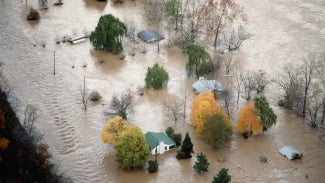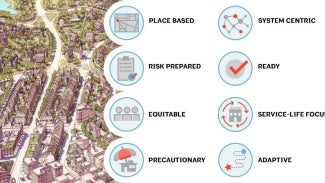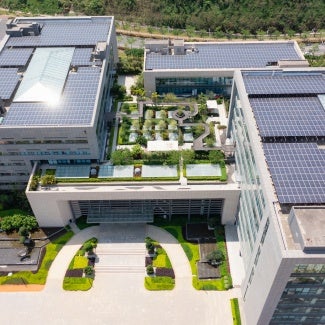Understanding resilience
This document defines mitigation, resilience, adaptation, sustainability and regenerative design, clarifying the characteristics of each strategy as well as the nuances of hazard, risk and vulnerability.

Buildings and communities are subjected to destructive forces from natural and human-caused hazards such as fire, earthquakes, flooding, sea level rise, tornadoes, tsunamis, severe weather, and even intentional attack. The forces affecting the built environment are evolving with climate change, environmental degradation, population growth, and migration; this alters long term conditions and demands design innovation.
Architects design environments that reduce harm and property damage, adapt to evolving conditions, and more readily, effectively and efficiently recover from adverse events. To do so effectively, it’s critical to utilize accurate terminology to communicate these issues as well as build trust and credibility.
This document defines mitigation, resilience, adaptation, sustainability and regenerative design, clarifying the characteristics of each strategy as well as the nuances of hazard, risk and vulnerability. The terms include an informal concept that clarifies application as well as a formal definition.
Hazard: poses a threat to safety
Hazards such as hurricanes, tsunamis, earthquakes, tornadoes, blizzards, drought, and wildfires are responsible for injury, death, and property damage as well as social and economic disruption. These events are no longer a one-off, once in a lifetime event; particularly when we look at the impacts of climate change.
Definition: A potential source of danger caused by a naturally occurring or human-induced process or event with the potential to create loss. [AIAU]
Risk: quantifies hazard threat
Risk defines the likelihood of occurrence and intensity of the hazard. Determining the level of “acceptable risk” is critical to designing for the associated level of building performance. It is important to ask: What is the projected lifespan of the building? What are the building’s critical functional requirements before, during, and after a hazard strikes? And how long is it acceptable for the building to be out of service due to the impacts of a hazard?
Definition: The potential for an unwanted outcome resulting from an incident, event, or occurrence, as determined by its likelihood and the associated consequences. [DHS]
Vulnerability: personalizes risk
Vulnerability assesses the capabilities and interdependencies of individuals and communities associated with risk. A resilient building in a vulnerable community isn’t truly resilient. Infrastructure, utilities, food supply and services are all necessary for adequate functionality.
Definition: The degree to which a system is susceptible to, and unable to cope with, adverse effects. [IPCC]
Mitigation: reducing negative impact
Mitigation measures are often developed in accordance with lessons learned from prior incidents. Measures may include zoning and building codes or floodplain buyouts as well as efforts to educate governments, businesses, and the public on measures they can take to reduce loss and injury. Mitigation is most successful when policies and decision-making support appropriate development, land use, site selection, and adoption of model building codes.
Definition: The lessening of the potential adverse impacts of physical hazards (including those that are human-induced) through actions that reduce hazard, exposure, and vulnerability. [IPCC]
Resilience: inherent durability or flexibility
When working within the built environment, it’s important to have foresight: incorporating changing environmental, social, and economic conditions into projects. This requires designs that are tough as well as flexible; providing the ability to not only bounce back, but forward.
Definition: The ability of a system and its component parts to anticipate, absorb, accommodate, or recover from the effects of a hazardous event in a timely and efficient manner, including through ensuring the preservation, restoration, or improvement of its essential basic structures and functions. [IPCC]
Adaptation: accommodating needs throughout service life
Hazards aren’t the only threat. It is critical to acknowledge the changing conditions in the physical, economic and social environment as well. Communities and buildings are ultimately successful when they are adaptable to change.
Definition: The adjustment in natural or human systems in response to actual or expected climatic stimuli or their effects, which moderates harm or exploits beneficial opportunities. [IPCC]
Sustainability: minimizing environmental impact
The concept of meeting present needs without compromising the ability of future generations to meet their needs.
Definition: Design that seeks to avoid depletion of energy, water, and raw material resources; prevent environmental degradation caused by facility and infrastructure development over its life cycle; and create environments that are livable, comfortable, and safe and that promote productivity. [Architect's Handbook of Professional Practice]
Regenerative Design: creating better conditions
Taking sustainability to the next level, regenerative design restores or improves the natural environment.
Definition: Restores and improves the surrounding natural environment by enhancing the quality of life for biotic and abiotic components of the environment. [WBDG]
The Fundamentals of Resilient & Climate Adaptive Design

Buildings and communities are subjected to destructive forces from naturaland human-caused hazards. The forces affecting the built environment are evolving with climate change, environmental degradation, population growth, and migration. Apply the eight Fundamentals of Resilient and ClimateAdaptive Design to reduce harm and property damage, adapt to evolving conditions, and more readily, effectively, and efficiently recover from adverse events.
Download the Fundamentals of Resilience and Climate Adaptive DesignGuide



